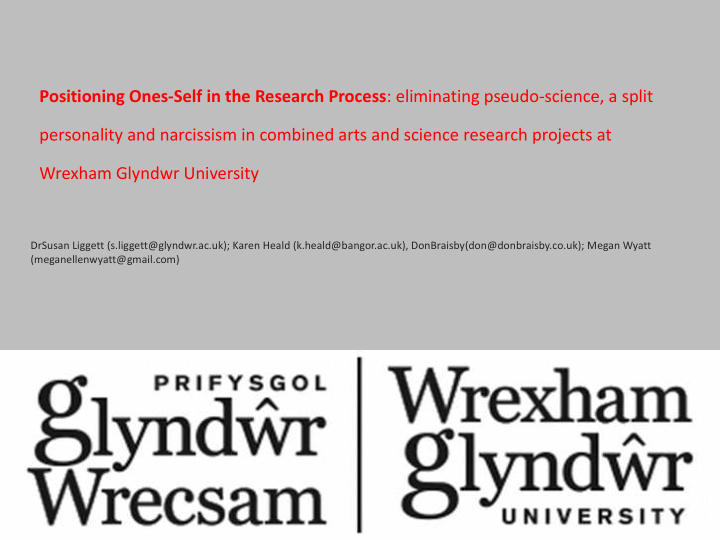



Positioning Ones-Self in the Research Process : eliminating pseudo-science, a split personality and narcissism in combined arts and science research projects at Wrexham Glyndwr University DrSusan Liggett (s.liggett@glyndwr.ac.uk); Karen Heald (k.heald@bangor.ac.uk), DonBraisby(don@donbraisby.co.uk); Megan Wyatt (meganellenwyatt@gmail.com)
Creative arts research outcomes and methodologies are sometimes difficult to understand and quantify in terms of traditional scholarship which can lead to a devaluing of studio based enquiry (Barrett, E.)
‘Pierre Bourdieu argues that tacit knowledge and the alternative logic of practice underpins all discovery; and yet the operation of this logic is often overlooked because it is subsumed into the rational logic of discursive accounts of artistic production’ (Barrett, E.2007 p.4).
Case Study1 In-between-ness: using art to capture a sense of self during anti-depressant treatment DrKaren Heald,DrSusan Liggett,DrRichard Tranter, Professor Rob Poole & Professor Catherine A Robinson
Research Questions How do we construct our reality? Can this process be manipulated through medications? If so, what are the implications for the authenticity of self for someone who has had such treatment?
The artists worked one-to-one with four participants over six weeks with a video camera film on a weekly basis. Visual prompts were introduced as a stimulus Videostillsfromparticipantsfilms 2011-2012)
Prompts (objects),Karen Heald & Susan Liggett (2011)
• Carefully selected purposive sample • Qualitative study using a variety of media and guidance from professional artists • 1-2-1 • Filming process / antidepressant treatment • Editing the artworks. • Mini-International Neuropsychiatric Interview and Beck Depression Inventory II. • Psychometric tests.
Findings revealed that the interview transcripts recorded positive benefits to participants in terms of increased responsiveness to sensations, their surrounding environment, the quality of their feelings and their sense of self when engaged in the creative process. The psychometric tests by contrast evidenced no change in symptoms. Haze
www.in-between-ness.co.uk
CaseStudy2 TacitKnowledge and Materiality within Painting as an immersive experience: A study of a creative dialogue between an artist and People living with Dementia in North Wales.
Participants living with Dementia will be invited to a workshop to make artwork with no visual stimulus. A body of work consisting of two and three dimensional paintings made from glass and ceramics will then be exhibited and the people living with dementia will be invited to attend.
These participants will then create another body of paintings in response to the visual stimulus of the exhibition. Paintings created before and after the introduction of a visual stimulus will beanalysedand compared. The researcher’s artwork will be exhibited alongside that of the participants.
Case Study3 How can the use of galvanic etching techniques enhance the work of the artists and printmakers?
Therationale for the research is a result of the awareness of the potential health and environmental hazards of traditional nitric acid etching techniques that have led to a decline in the teaching of intaglio etching.
Drawing a rich picture is a process that is used in the Soft Systems Methodology (SSM) developed byCheckland(1981). Images and words are drawn out on a large sheet of paper to describe the problemsituation.
The rich picture process identified that there are two aspects to the researchquestion: 1) Relates to the research into the galvanic technique. 2) Relates to the use of the techniques in practice.
Thisworld was engaged with through: workshops (electro-etching); presentations (using the rich picture); collaborative work (other artists) and interviews. The research strategy developed was based on a hybrid model of both the practice based and practice led methods. The quantitative (practice-led) research collected data by experimentation and developed a new process to produce theartwork. Its impact on practice evident in creation of artworks (practice based).
Opportunity for participants to engage in creative sessions and present their videos, film stills and artist books in professional exhibitions Participants Artistic Collaborative Methodology Being in-between Artists Scientists Video / objects PaintingReductionism Clinical trials In-between-ness Psychological Resonance Social Psychological effects of Antidepressants Aesthetics Creative practice, visual artworks Future patient care Creative research & international expositions emotional processing Transitory Strata wider dissemination
Whenviewing and making artwork, it is not merely the deciphering of reality which occurs, as new understandings emerge and connections and explanations are exposed to both viewer and artist. Viewing and creating artwork can transform ones understanding to inform and generate new and valid knowledge (Sullivan,2005). Practice based research is used in these projects as it allows for new outcomes which do not oppose a verbal explanation (Niederrer, 2007).
In-Between-ness exhibition of artists and participants work, Oriel Sycharth Gallery, 2013 Paper Interior photograph from video performance Heald, K. & Liggett, S. (2013)
Accordingto MichaelPoianyi(1962) aesthetic insights ‘motivates the early stages of much scientific research’ (cited in Rust, C. 2007).
Thank you for listening s.liggett@glyndwr.ac.uk www.susanliggett.com www.in-between-ness.co.uk https://donbraisby.me/ http://meganwyatt.co.uk/
Recommend
More recommend